In performing the clinical examination we need a place to start. The hands are the answer. Start by shaking the patient’s hand in greeting and the rest will follow. We need to remember how invasive an examination is for the patient and also remember how necessary it is. The clinical examination should progress smoothly from one part to the next. Let’s start now, with the hands.
SHAKE HANDS
Feel the palms. Are they moist? Is this nervousness? Could it be secondary to thyrotoxicosis? Is there a tremor and are there eye signs of the latter? Does the patient have difficulty letting go of the handshake? Rare as this is, it is some kind of myotonica, think Dystrophia Myotonica.
LOOK AT THE HANDS
Are they enlarged, as in acromegaly?
Are they distorted as in arthritis?
Rheumatoid Arthritis
- Ulnar deviation
- Boutonnierre deformity
- Swan neck deformity
- Z deformity of the thumb
Osteoarthritis
- Heberden’s nodes(DIP joint)
- Bouchard’s nodes (PIP joint)
Are the fingers sausage shaped?
- Think of Psoriatic arthropathy and Reiter’s disease
Is there finger shortening?
- beware not to miss destructive arthritis (arthritis mutilans) of psoriatic disease
Is there wasting of the palm, or other part of the hand?
Are the fingers held abnormally?
The MEDIAN nerve controls the Lumbricals 1 & 2 as well as the thenar muscles OAF (Opponens pollicis, Abductor pollicis brevis and Flexor pollicis brevis)So together the LOAF muscles.
The ULNAR nerve supplies all other small muscles of the hand.
 The Benediction Sign or Pope’s Hand results from the inability to flex the 2nd and 3rd digits at the metacarpophalangeal joints, due to the lumbricals not being innervated. This is as a result of median nerve injury at the level of the elbow. The same sign is sometimes incorrectly used, for the claw-like hand of ulnar nerve damage. In the ulnar claw hand, the 4th and 5th digits are extended at the metacarpophalangeal joints(MCPJ) and flexed at the interphalangeal joints.
The Benediction Sign or Pope’s Hand results from the inability to flex the 2nd and 3rd digits at the metacarpophalangeal joints, due to the lumbricals not being innervated. This is as a result of median nerve injury at the level of the elbow. The same sign is sometimes incorrectly used, for the claw-like hand of ulnar nerve damage. In the ulnar claw hand, the 4th and 5th digits are extended at the metacarpophalangeal joints(MCPJ) and flexed at the interphalangeal joints.
To distinguish between a median and ulnar nerve lesion, ask the patient to clench the hand into a fist. The patient with a median nerve injury CANNOT CLENCH THE FIST as the index and middle finger cannot be flexed by the lumbricals. With median nerve lesions, the more proximal the lesion, the greater the deformity. With ulnar nerve lesions, there is the ‘ulnar nerve paradox’, where the more distal lesion causes the greatest deformity.
In Ochsner’s clasping test ask the patient to clasp their fingers together, with a median nerve injury, the index finger does not flex at the MCPJ.
In Froment’s Sign you ask the patient to grasp a piece of paper between the thumb and the lateral aspect of the forefinger. Loss of power to adductor pollicis (supplied by a deep branch of the Ulnar nerve) of the thumb will cause flexion of the distal thumb as Flexor policies longs compensates.
Normal Ulnar Nerve
 Abnormal Ulnar Nerve
Abnormal Ulnar Nerve
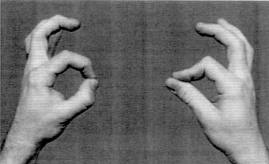 In patients with a median nerve palsy, the inability to oppose the thumb can result in a pinching motion when asked to make the ‘OK’
In patients with a median nerve palsy, the inability to oppose the thumb can result in a pinching motion when asked to make the ‘OK’
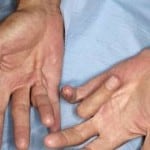 Look for Dupuytren’s contracture, usually causing flexion of the ring finger(but may also be of the 5th finger). It results from thickening of the palmar fascia and may be familial, or occur secondary to trauma, or be related to alcoholism(not liver disease)
Look for Dupuytren’s contracture, usually causing flexion of the ring finger(but may also be of the 5th finger). It results from thickening of the palmar fascia and may be familial, or occur secondary to trauma, or be related to alcoholism(not liver disease)
 Are there Osler’s Nodes? Painful, nodes on the fingers or toes as a result of immune complexes in endocarditis.
Are there Osler’s Nodes? Painful, nodes on the fingers or toes as a result of immune complexes in endocarditis.
 Are there Janeway lesions? Non-painful lesions in the palms or the soles as a result of septic emboli, most commonly in Staph aureus infective endocarditis.
Are there Janeway lesions? Non-painful lesions in the palms or the soles as a result of septic emboli, most commonly in Staph aureus infective endocarditis.
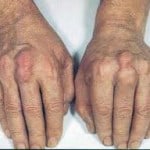 Are there Tendon Xanthomata? These are yellow lipid deposits in the tendons occurring as a result of type II hyperlipidaemia.
Are there Tendon Xanthomata? These are yellow lipid deposits in the tendons occurring as a result of type II hyperlipidaemia.
NEXT LOOK AT THE NAILS.
So much can be diagnosed by looking at the nails; cardiac disease, liver disease, renal disease and more.
Look for the following three characteristics:
- Colour
- Defects
- Patterns
Colour
 White Nails ( Leuconychia), may indicate hypoalbuminaemia and chronic liver disease. It can appear as either a white nail or white spots on the nail.
White Nails ( Leuconychia), may indicate hypoalbuminaemia and chronic liver disease. It can appear as either a white nail or white spots on the nail.
Red Nails– think of polycythaemia or carbon monoxide poisoning
Blue Nails – think cyanosis and Wilson’s disease
Yellow Nails – These are the result of hypoplasia of the lymphatic system. The distal nail is separated.
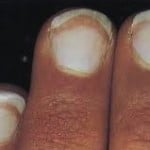 Terry’s Nails – the proximal nail is pale and the distal nail is darker, but it is not half and half. It results from liver disease, congestive cardiac failure and diabetes.
Terry’s Nails – the proximal nail is pale and the distal nail is darker, but it is not half and half. It results from liver disease, congestive cardiac failure and diabetes.
 Lindsay’s Nails or half and half nails. The proximal portion is white or pink and the distal portion is red or brown. They are in a ratio of 50% each. It indicates chronic renal failure.
Lindsay’s Nails or half and half nails. The proximal portion is white or pink and the distal portion is red or brown. They are in a ratio of 50% each. It indicates chronic renal failure.
Defects
Clubbing
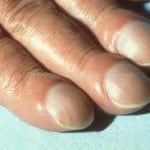 There is a loss of hyponychial angle ie., between the nailed bed and the finger. There are many causes of clubbing, all easily found in the examination textbooks. I remember 2 causes in each system for clubbing.
There is a loss of hyponychial angle ie., between the nailed bed and the finger. There are many causes of clubbing, all easily found in the examination textbooks. I remember 2 causes in each system for clubbing.
Cardiovascular
- Cyanotic Congenital Heart Disease
- Infective Endocarditis
Respiratory
- Abscess including empyema and bronchiectasis
- Carcinoma
GIT
- Cirrhosis
- Inflammatory Bowel Disease
Also UNILATERAL CLUBBING, remember the following:
- Bronchial arteriovenous aneyrysm
- Axillary Artery aneurysm
Splinter Haemorrhages
These are painless lesions that look like a splinter under the nail. Causes include: trauma, infective endocarditis, Raynauds’s Disease and vasculitis. A splinter haemorrhage under one nail may be due to trauma, however, if they appear on more than one digit, think of systemic disease.
Koilonychia
 This is a spoon shaped nail that can occur in iron defeciency anaemia, fungal infections and Raynaud’s Disease.
This is a spoon shaped nail that can occur in iron defeciency anaemia, fungal infections and Raynaud’s Disease.
Onycholysis
The nail lifts from the nail bed. It occurs in Psoriasis and Thyrotoxicosis and may also occur in infection and trauma, although traumatic causes are localised to the affected nail(s).
Patterns
There are three patterns to look for in the nail:
Beau’s Lines 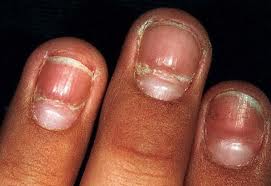 These are transverse depressed ridges, that occur in Infection, Hypocalcaemia, post surgery, post chemotherapy, post Kawasaki’s Disease and in myocardial infarction. They are believed to be causes by a temporary cessation of cell division in the nail.
These are transverse depressed ridges, that occur in Infection, Hypocalcaemia, post surgery, post chemotherapy, post Kawasaki’s Disease and in myocardial infarction. They are believed to be causes by a temporary cessation of cell division in the nail.
Muehrcke’s Lines  These are hypo pigmented, or opaque transverse bands, but are NOT depressed. They are white bands that run parallel to the lunula and in a transverse manner. They are caused by decreased protein synthesis, or in times of significant illness. Causes include, hypoalbuminaemia, nephrotic syndrome, during chemotherapy or other acute illness.
These are hypo pigmented, or opaque transverse bands, but are NOT depressed. They are white bands that run parallel to the lunula and in a transverse manner. They are caused by decreased protein synthesis, or in times of significant illness. Causes include, hypoalbuminaemia, nephrotic syndrome, during chemotherapy or other acute illness.
Mee’s Line 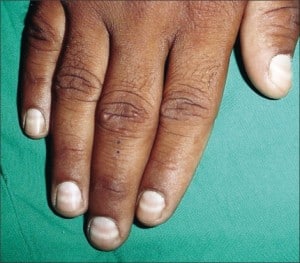 They are a single transverse white line that has no depression. They are produced during times of significant metabolic stress. Causes include arsenic poisoning, thallium, renal disease, cardiac failure and malignancy. (Image reference: The Lancet, Volume 372, Issue 9647, Page 1410, 18 October 2008)
They are a single transverse white line that has no depression. They are produced during times of significant metabolic stress. Causes include arsenic poisoning, thallium, renal disease, cardiac failure and malignancy. (Image reference: The Lancet, Volume 372, Issue 9647, Page 1410, 18 October 2008)
NEXT
The hand examination is now complete.
I would next move to the arm. The first part is to palpate the radial artery at the wrist, look for radial-radial and radio-femoral delay,slide the hand up to the epitrochlear node, the axillary nodes, take the blood pressure and more…..but this is in the next part.
Examination of the hand; it takes less than a minute and gives a wealth of information about the patient.
Peter Kas

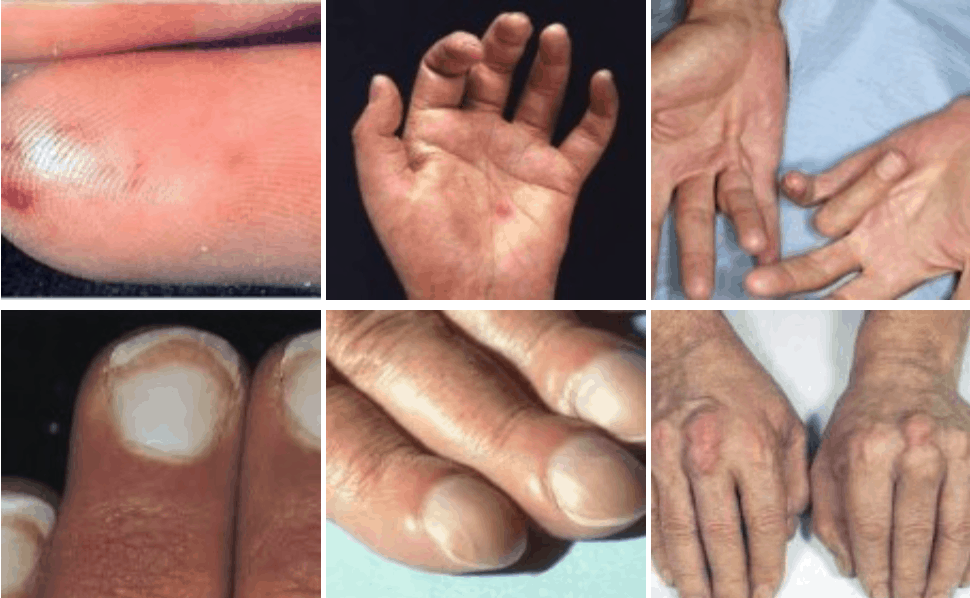




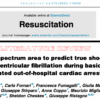








24 Comments